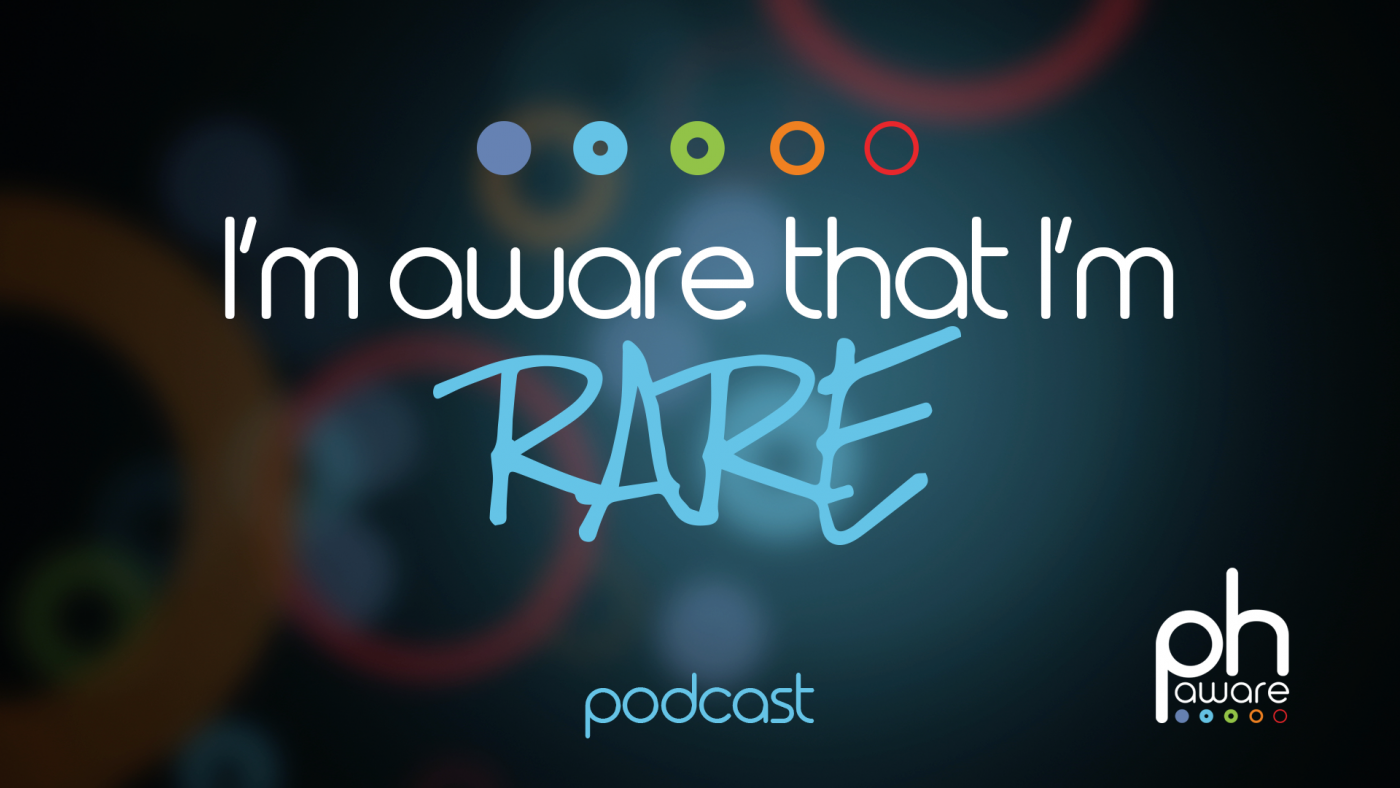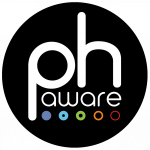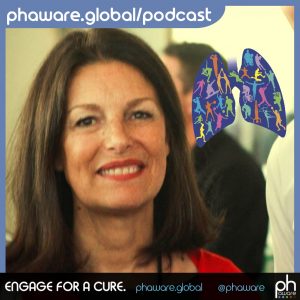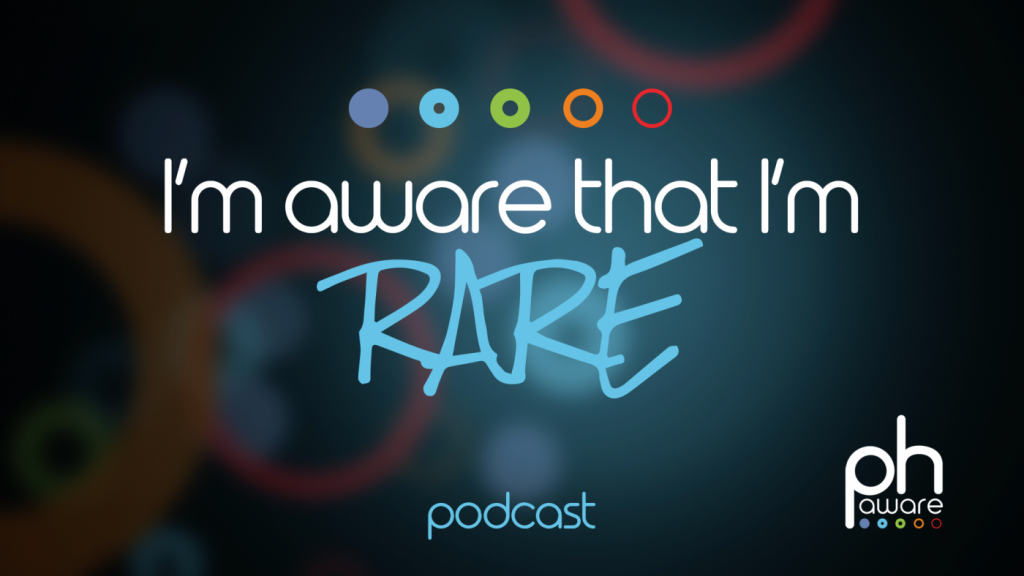Phaware Podcast: Pisana Ferrari

This podcast series, created and produced by phaware, is a regular guest feature on Pulmonary Hypertension News. It brings the voices and life experiences of PH patients, family members, caregivers, healthcare specialists, and others to our readers. You can listen to the podcast, or read the transcript here.
I’m Aware That I’m Rare: Pisana Ferrari
The phaware™ interview
Pisana has been active in patient advocacy for 15 years, since 2001, when she and other patients suffering from pulmonary arterial hypertension founded the Italian PH patient association AIPI. In 2003 she was a founding member of PHA Europe, the European federation for PH. Pisana is also a double lung transplant recipient who shares her story on the 15th anniversary of her transplant procedure. Pisana also discusses the importance of advocacy and awareness and the annual global event World Pulmonary Hypertension Day (May 5) #WorldPHDay.
Hello, I’m Pisana Ferrari and I come from Italy.
My connection to the PH community dates back many, many years ago. I was diagnosed with idiopathic  pulmonary hypertension in 1988. At the time, there was nothing happening in the field of PH. There were no drugs, no PH centers, no guidelines, so it was very difficult being a patient in those days. Not only were there no drugs, but there was really nothing happening at all, not even any internet.
pulmonary hypertension in 1988. At the time, there was nothing happening in the field of PH. There were no drugs, no PH centers, no guidelines, so it was very difficult being a patient in those days. Not only were there no drugs, but there was really nothing happening at all, not even any internet.
I was lucky enough to be reasonably well for a number of years. It’s not until 12 years after my diagnosis that I was first put on a treatment. I was in a study, actually. I was quite late-stage diseased by then, so I was listed for a double lung transplant. The transplant was performed in 2002 and in fact, tomorrow I’m celebrating my 15th anniversary for my transplant.
PH has occupied 30 years of my life, half of my life.
I think research is really important for patients and they should seriously consider when they’re offered this possibility. In some countries or in some situations, this may be the only way to have drugs. In my particular case in 1988, there was nothing else, so being put in a trial gave me the opportunity to try a drug before it was put on the market, gaining at least one or two years.
My pulmonary hypertension obviously progressed with time. Perhaps I was put on the trials a bit late. Not late in absolute terms, but in terms of how severe my condition was by then. I arrived at the transplant very weak, very thin, and in a very advanced stage of the disease. That, of course, made matters worse in the sense that time to recover was difficult and I had a lot of complications post-transplant.
I was very lucky to make it through the transplant. I recovered relatively quickly. It took me about three months to get back on my feet. Over the next couple of months, I was completely fine and in fact, now it’s been 15 years and I lead a completely normal life. I have a full-time job, family, and all sorts of activities.
I started getting involved in the PH community actually in 2001 — went together with some other patients in my own country, in Italy. We founded a small patient group, which has since become quite large and very active. Two years later, I was invited to the very, very first meeting of a few associations from around Europe that got together with the idea just of meeting. This meeting was so successful, it was in Vienna in 2003 during one of the big congresses, that we decided to create an umbrella organization.
At that time, there were only eight countries involved. Over the years, we created a structure, we became more organized, and it’s become a very large group. We now have 39 member associations from 33 countries, so we’ve come a very long way.
After my transplant, I decided to have an active role in PHA Europe. Since 2010, I’m actually working full-time. PHA Europe has grown steadily over the past few years with new countries joining every year, two or three. PHA Europe has set up programs to help patients or caregivers in countries to set up an association. We have a program called White Spots. The White Spots are the countries in Europe with no patient association. Through this program, we’ve helped many set up and start their activities. We’ve provided guidance and funds for websites, registration, legal fees, and so on.
Of course one of our biggest problems was that as the group grew, there were so many languages that it was very difficult to communicate. You can imagine, it’s about 30 languages because some countries share a language, so we set up another program called the Fellowship program whereby PHA Europe pays for part-time English speaking assistants for the associations where there are really some big communication issues.
For our members to be able to involved in the work, communication is vital. You can’t communicate if I write an email in English and the person at the other end has to find somebody to translate it into Hungarian or whatever, then has to reply and translate the reply and so on. This program has helped enormously.
We now have a very, very smooth flow of information. We have 23 fellows. Twenty-three countries have this opportunity and that’s helped enormously. These two programs, White Spots and Fellowship, have been set up really to help our members start up and grow and then become active in their own countries with the patients.
We are not in direct contact with the patients; we are more involved in global initiatives, global awareness campaigns like World PH Day, and advocacy activities, so an organ donation and transplant with European institutions. We’re involved in discussions on pricing, health technology assessment, and rare disease policies in some of the big public health organizations in Brussels. Also in the professional societies and also in the EMA, for example, and so also with regulatory.
The really big challenge for PHA Europe is that there are huge inequalities across Europe in access to drugs and surgery. We have some countries where all the drugs are available. There are countries where one or two are available and there are unfortunately even countries where no drugs are available and no surgery. This is our really major challenge and that’s why we’re involved in a lot of advocacy.
Not only are we doing advocacy in Brussels, let’s say, with the institutions and other bodies within larger organizations, but we’re also supporting national advocacy activities, so by taking part in meetings and supporting with the letters to ministers or health authorities, whatever the case may be. Of course it’s very different from one country to the other.
The other big problem is that not all of our members are members of the E.U. In the countries which are not part of the E.U., the situation is even worse. I’m thinking of countries like Bosnia or Ukraine. People there are really helpless. There’s also countries where there are huge financial problems, for example, Greece. It’s not a homogeneous population. There’s a lot of different situations and that’s the challenge.
Transplant is another big issue. There are countries where there’s no transplant, so they either are part of some exchange programs that, for example, Vienna has with Eastern Europe. They have agreements whereby the countries provide the organs and Vienna accepts to perform surgery on the nationals from that country. There are countries in Europe that don’t do transplants. They don’t have a program, a national program for lung transplant, for example, which is one of the most complex. In that case, they either manage to go abroad or there’s no other option for them. With the drugs, survival has improved a lot and quality of life.
When you’re at end-stage disease, the only option really is transplant. It’s not only a question of financial, but also of competencies. There may not be the necessary competencies in a country, people that are actually able to do it, to perform it, so it’s also a problem of education of doctors. It’s financial, it depends on the national health policy; there’s a lot of different variables.
For many, many years, I had no drugs and there were no centers, that I felt very, very isolated. That’s one of the big problems with pulmonary hypertension. At the time, it was worse of course because I didn’t meet any real patients until many, many years after my diagnosis. The isolation is a very real problem not only for that reason, but because the disease is very little known and not visible. Sometimes even your closest family members or your friends don’t really understand how severe the disease is.
I cannot stress enough how important it is to join or be supported by a patient association where you can meet other people with your same problems, share and learn from each other. Get the kind of support that you may not be able to get from your doctor — that’s not really the role of doctors and they don’t have the time — or from your family members and like, for example, easy to understand information and resources on different aspects of the disease.
Also, the needs of patients will vary according to the time from diagnosis. The information they will need at the time of diagnosis will be different from that when they’re in a more advanced stage of the disease, when they’re being listed for transplant or for other surgery. I think that that’s an important aspect of the role of patient associations.
One of the greatest achievements that we’ve had over the past few years has been the World Pulmonary Hypertension Day. This was launched in 2012 and it was a bit of a gamble by the Spanish association. We didn’t know whether people would [or] other associations around the world would join this movement. What’s been incredible is that over the years, associations from all over the world have embraced it and are conducting World PH Day events in their own countries. Last year — and it’s not just Europe — last year, there were 30 in Europe alone and another 17 around the world.
This started as a very small initiative in Spain and it’s grown to a movement which has produced, it’s gained a lot of media attention. It’s contributed also to the feeling of being part of an international community. I think when you have joint initiatives that are this big across continents, across countries, that creates a sense of belonging and of community. Of course, it also reinforces our message. We have a stronger voice.
When we started out with World Pulmonary Hypertension Day and we had to choose a theme, and I’m talking about Europe now, we thought that sports is something that has a very broad, very universal appeal. We felt that the idea of people involved in high-energy activities, running or racing in solidarity with the patients who were faced with very big physical limitations and who can’t, was a good way to raise awareness about the disease.
That’s how the slogan “Get Breathless for PH” was launched — with the idea that people would race for those who can’t. It was also a show of solidarity. It worked very well the first year, so since then, we’ve kept it. Many of you may have seen the logo with the two blue lungs and inside the lungs are different sports being played. It’s linked to the sports theme. We’re going to use this same theme this year.
I have to say that there are other countries around the world using different ideas and of course, that’s also great. I’m very happy. I was happy to see the countries around the world did also pick up on our blue lungs T-shirts, which is nice, and on the colors, which are usually blue or mauve.
Our member associations are extremely active at national level. They’ve accomplished quite a lot in many different ways. This is even for small associations within small countries. It takes maybe one good event where you connect with a celebrity or a health authority and you can gain an incredible amount of awareness. You can create a lot of awareness. I think there’re no limitations. It’s not only the big associations that do a lot, it’s also the small ones. It’s really up to the individuals that are involved to come up with something that’s creative, interesting, and that can catch attention.
I’m really happy to see that we have a mix of big and smaller ones. Some are more recent, some have been established for a long time. They’re being run by very dynamic, very motivated, passionate and dedicated people who are really doing their best in their own countries to help the patients, and who are also very happy to work within the European PH community to do things together. It’s very rewarding for me being kind of the European coordinator to see how enthusiastic they are and how well everything’s going.
If we think in terms of successes, I think you have to think that success can mean a very different thing in a country like Bosnia. It could be simply having one drug would be very successful. In other countries, which are more fortunate and privileged, a success might be achieving that psychosocial support is reimbursed. It really depends on the countries.
Success is very relative. It’s relative to the situation of the association, of the patients, of the economics, and political as well. There’s no one success. I think for any organization, success is very much linked to how you can manage to create a sense of community. I think that is a very good indicator of success. When people like working together, they participate actively.
I can say this about the association in Italy, which I co-founded with other patients. It’s touching to see how people, when they come to our meeting, they say that they’re coming to the family meeting. They’re all hugging each other and kissing and crying and sharing and this whole thing. That’s what I call, what I think is one of the main ingredients of success. If you’re a tightly knit group and you share values and objectives and so on, you can be more successful in other things as well. I think it adds to what you can achieve.
My name is Pisana Ferrari and I’m aware that I’m rare.
EVERYBODY HAS A STORY. WHAT’S YOURS?
Phaware wants to share your pulmonary hypertension story with their engaged global audience. Whether you are a patient, caregiver, or medical professional, they are enlisting PH community members from across the globe. Visit www.phaware.global/podcast to be considered for a future episode.
And learn more about pulmonary hypertension at www.phaware.global. #phaware #phawarepod
Note: Pulmonary Hypertension News is strictly a news and information website about the disease. It does not provide medical advice, diagnosis, or treatment. This content is not intended to be a substitute for professional medical advice, diagnosis, or treatment. Always seek the advice of your physician or other qualified health provider with any questions you may have regarding a medical condition. Never disregard professional medical advice or delay in seeking it because of something you have read on this website. The opinions expressed in this column are not those of Pulmonary Hypertension News or its parent company, Bionews Services, and are intended to spark discussion about issues pertaining to pulmonary hypertension.










Leave a comment
Fill in the required fields to post. Your email address will not be published.